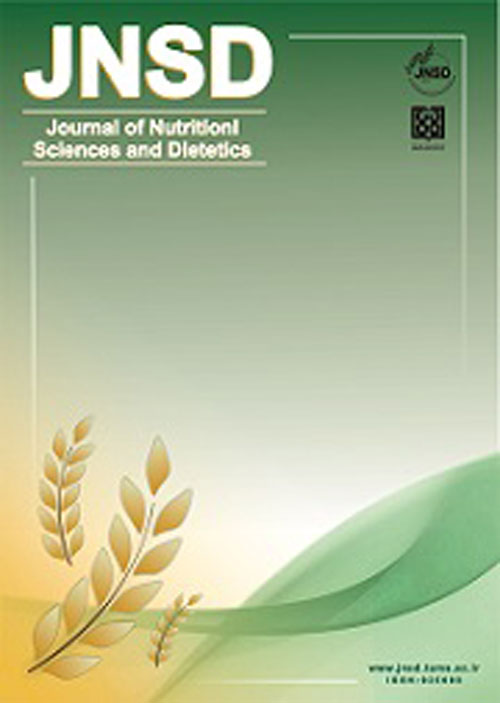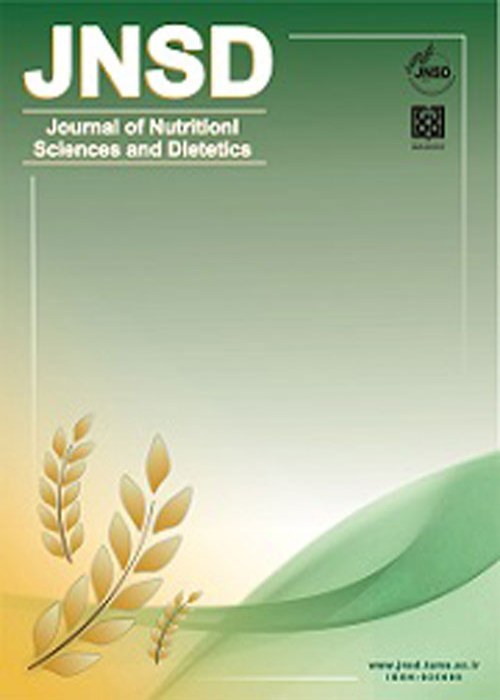فهرست مطالب

Journal of Nutritional Sciences and Dietetics
Volume:3 Issue: 4, Autumn 2017
- تاریخ انتشار: 1396/12/20
- تعداد عناوین: 5
-
-
Pages 1-8Background
Obesity and overweight are a critical public health problem, recognized by excessive fat gain. Worldwide, many natural products for treatment of obesity and weight loss have been used .It seems natural supplement usage, based on traditional plants is a safest approach for obesity and recent experiments revealed many herbal medicinal products as a useful treatment of obesity.
MethodsIn this study, we used an herbal formulation consist of four traditional plants including Origanum vulgare, Carum carvi, Trachyspermum copticum and Ruta Graveolen as an anti-obesity supplement in obese adult subjects. An eight-week clinical trial, double-blind and randomized placebo-controlled study were undertaken in adult obese subjects. Sixty-eight subjects were randomly assigned into two groups of placebo (n = 34) and treated (n = 34). Anthropometric indices, dietary intake and biochemical parameters were measured at baseline and after the intervention.
ResultsThe results indicated body weight, BMI and body fat composition in treatment group was significantly lower than control (p
ConclusionsIn conclusion, this herbal mixture effectively reduced body weight and fat mass in adult obese subjects. It also showed potential efficiency in controlling lipid profile level in obesity individuals.
Keywords: Herbal, Obesity, Traditional, Randomized trial -
Efficacy of Propolis in Diabetic Foot Ulcer Management (or Treatment): A Randomized Controlled TrialPages 9-13Background
The impaired wound healing in diabetes mellitus is a major clinical problem. Propolis has pharmacological characteristics. This study aimed to evaluate the effects of oral, topical, and oral combined with topical administration of propolis on foot ulcers in diabetic patients.
MethodsEighty patients with diabetic foot ulcers were divided into 4 groups. Group 1 received propolis ointment (3%, 1.5 g daily), Group 2 received three 500-mg propolis capsules per day, Group 3 received capsules and ointments, and Group 4 received the usual treatment of foot ulcer, including washing with physiological serum. The patients were treated for 4 weeks. Wound surface area changes were analyzed to determine the effectiveness of the compound in wound healing.
ResultsThe interventions decreased foot ulcer surface areas in all intervention groups (from 685.13 ± 286.16 to 74.89 ± 26.40 mm2 [p = 0.03] in Group 1, from 616.52 ± 221.11 to 104.60 ± 39.81 mm2 [p = 0.046] in Group 2, and from 647.07 ± 23 to 54.20 ± 19.17 mm2 [p = 0.01] in Group 3). In Group 4, however, the reduction in ulcer surface area was not statistically significant. In the three experimental groups, the wounds were clinically improved in all subjects.
ConclusionThis study showed that in diabetic foot ulcers, treatment with either oral propolis capsules or combination therapy with oral and topical forms, significantly improves wound healing. Also, the application of these products does not seem to be associated with any unexpected adverse event.
Keywords: Diabetes mellitus, Diabetic ulcers, Propolis, Wound healing -
Pages 14-21Background
Dietary management is the principle intervention for obesity, although other methods have been proposed including non-invasive devices in body-contouring.
ObjectiveWe aimed to explore the effects of Radiofrequency (RF) and Ultrasound (US) modalities for the body-contouring in overweight females followed by evaluation of anthropometric, hematological markers and anti-HSP27 level.
MethodsIn this randomized control clinical trial fifty overweight females were enrolled and divided into two groups. Each participant was prescribed a diet with 500 kcal deficit of total energy requirement. RF and Ultrasound-Cavitation were each used once a week for 5 weeks in the case group. Anthropometric and hematological markers were measured in all subjects before and after intervention.
ResultAbdominal circumference(AC), waist circumference(WC), Body mass Index, and body fat mass parameters were reduced significantly in both groups (p
ConclusionsOur study suggests that body-contouring devices based on RF and US Cavitation reduced measures of adiposity and did not have adverse effects on hematological-factors, liver-function-markers, and HSP27 level in overweight women. Further investigations are required to explore the value of this method in a larger multicenter setting.
Keywords: Overweight, Hb, HCT, Radiofrequency, Ultrasound cavitation, Adverse effects -
Pages 22-27Introduction
Today, cardiovascular diseases are one of the main causes of mortality around the world including in Iran. One of the important factors in these diseases is healthy nutrition behaviors. Therefore, the current study aims to investigate preventive nutrition behaviors for cardiovascular diseases in women in city of Behbahan based on health belief model.
Materials And MethodsThis descriptive study was carried out in year 1394 (March 2015 to March 2016) on 63 housewives visiting healthcare centers in city of Behbahan. Data gathering tool was a valid and reliable questionnaire based on health belief components filled by participants in the study. Gathered data was analyzed using ANOVA and Pearson correlation test at the significance level of P
ResultsThe average knowledge score of women was 68.57±14.25 while the average scores for sensitivity and perceived intensity were 55.65±10.02 and 58.63±12.67 respectively. The average scores for perceived benefits, perceived barriers and self-sufficiency were 63.68±13.19, 59.46±15.83 and 43.84±7.27 respectively. The difference of average scores between people with and without previous diet experiences was not significant in any of the dimensions. There was also no significant difference between average scores of people with and without family history of cardiovascular diseases (P>0.05).
ConclusionBased on awareness and knowledge level of women, it seems that implementation of programs based on educational models can help reduce the number of cardiovascular diseases.
Keywords: Health belief model, nutrition, cardiovascular diseases -
Pages 28-31
Attention-Deficit Hyperactivity Disorder (ADHD) is a neuro-developmental syndrome very common among children. The main cause of this disorder is unknown and it seems that a combination of genetic, biological, environmental, psychosocial, neurochemical and nutritional factors are involved. One of the ethiological factors for ADHD is reported to be diet, and lower levels of long-chain omega-3 fatty acids are reported in children with ADHD. . In order to achieve studies on the relationship between omega-3 fatty acids and vitamin D, A review was conducted in diffrrent databases including Google scholar, Science Direct, SID, Pubmed and MagIran and key words were used including Omega 3/6 fatty acid, PUFA, ADHD, Vitamin D, Nutrient . 52 articles were reviewed and finally 30 articles were selected.After searching the keywords in different databases including Google scholar, Elsevier, SID, and MagIran, 50 studies were reviewed on the efficacy of Omega-3/6 fatty acids and vitamin D on children with ADHD and it was concluded that omega-3/6 fatty acids and vitamin D supplements have potential efficacy in decreasing the ADHD symptoms among children, but further studies are needed to find the underlying mechanisms of such treatments and to determine the optimal concentrations of these treatments, if it is better to be used as a single treatment or in combination with other medication.
Keywords: ADHD, Omega, 3, 6 fatty acids, Vitamin D, Nutrient supplements


